Finale’s ‘Kensington’ Speakers – Big Horns Excite Us!
A Gold Star Winner
‘In the House’ Review by David Neice
MSRP $12,999 (CAD)

Verdict: ‘Go big or go home’ might be the advertising lead for these OEM speakers from Robert Gaboury’s Arteluthe workshop in Montreal. Large cabinets house an exceptional 15-inch woofer and a honk-free compression horn tweeter in a two way ported design that offers 100 db sensitivity. Even the smallest output single-ended amp can drive them to window shaking levels.
Breath taking audio is on tap for anyone well-heeled enough to afford a pair and with the space to accommodate them. Despite their price, they deserve a Wall Of Sound Gold Star and we have so designated it. We must also say ‘well done’ to the design team and Finale.
The Image of Big Horns
Pipe and slippers!! Yikes – how exactly did that term come to be used to describe a certain kind of high end speaker? I mean who even knows someone who smokes a pipe these days?

The origin of the term seems to partly lie in North American advertisements from the late 1950s/early 1960s, where Dad is seen sitting in front of massive speakers, such as Altecs, with feet up and pipe in hand, and Mom is bringing him a round of milk and cookies. Then there is the British version where Dad is sitting in ‘the lounge’ in front of a pair of Quad 57s and is seen smoking a pipe, wearing a sweater and with slippers on his feet, yet again while Mom is dutifully hovering somewhere in the background and ever-smiling.
In other words, it’s a metaphor for ‘relaxed’ listening and an ‘easy going and cheerful post-war demeanor’. Such metaphorical descriptions show us just how sophisticated speaker ‘talk’ has evolved. Back then, Hifi targeted the entire population. Today, audio outsiders would be clueless.
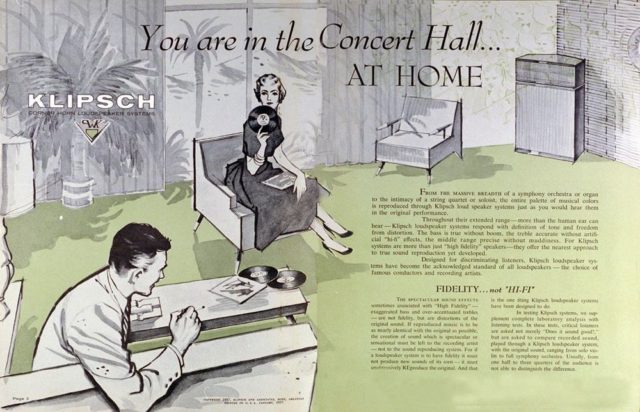 Which brings us to the Finale Kensingtons. These speakers are fairly massive, similar in size and shape to a modern day Klipsch Cornwall, with a driver arrangement that recalls the vintage JBL L200. They have the big 15-inch Faital Pro mid-woofer, two low-riding front ports and a horn compression tweeter with a sizeable horn lens that directs the horn output downwards. In the words of Finale’s Frank Ng, they are perhaps a bit ‘retro’.
Which brings us to the Finale Kensingtons. These speakers are fairly massive, similar in size and shape to a modern day Klipsch Cornwall, with a driver arrangement that recalls the vintage JBL L200. They have the big 15-inch Faital Pro mid-woofer, two low-riding front ports and a horn compression tweeter with a sizeable horn lens that directs the horn output downwards. In the words of Finale’s Frank Ng, they are perhaps a bit ‘retro’.
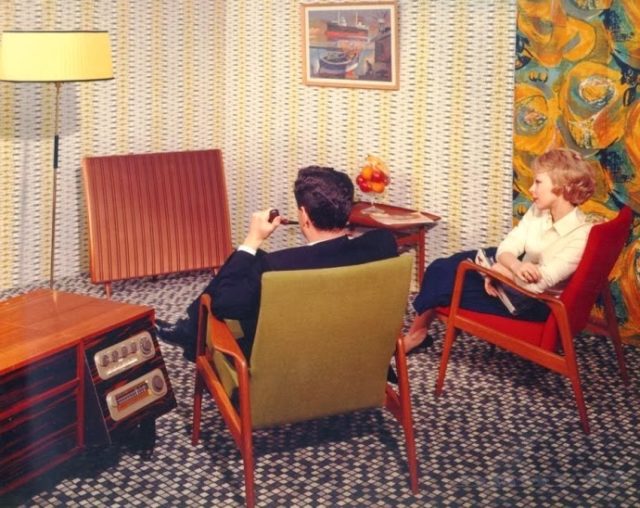 What an understatement, as they just don’t look like any of the slim column speakers that are today’s vogue. Wide, deep, and tall, they dominate all but the largest rooms, and would be right up there with the Cornwalls for size kings. The physical image they project is all pipe and slippers but it would be a grave mistake to imagine that they sound that way, as these speakers sounds as modern as most anything in today’s market.
What an understatement, as they just don’t look like any of the slim column speakers that are today’s vogue. Wide, deep, and tall, they dominate all but the largest rooms, and would be right up there with the Cornwalls for size kings. The physical image they project is all pipe and slippers but it would be a grave mistake to imagine that they sound that way, as these speakers sounds as modern as most anything in today’s market.
“Oh – but the delicacy”! This is a reader spoiler alert, but more about that later in the review.
Some Technical Features
Let’s start with a few technical details. These speakers are 100 db efficient and can be driven with even a two- or three-watt-per-channel amplifier. As many of you will know, this is the particular amplifier specialty of Triode Lab/Finale Audio, who bring the Kensington to market. Their idea is to have a speaker that can rattle the windows even with the tiniest amplifier output, particularly single-ended amplifiers, even a design based on the 45 or 2A3 triodes. The speaker was in fact voiced with a Triode Lab 2A3 SET.
The cross-over point is 1200 Hz, where the big mid-woofer begins to hand duties over to the horn tweeter. As concert pitch A is 440 Hz, this means that the crossover is fully in play at about one and a half octaves above concert pitch. If you look at a piano you will see that about (roughly) 70% of music’s fundamentals will be covered by the mid-woofer, and most upper octave fundamentals as well as upper harmonics will then emanate from the tweeter. Some designers prefer crossover points as high as 3000 Hz, to keep the vast majority of fundamental tones below the crossover slope, and alleviate some of the midrange driver’s workload, while others prefer a lower point, in the 1200 to 1500 Hz range.
Much depends of course on the drivers being used, and on the design of the crossover and how it blends and integrates the drivers. The cross-over in this case is a Linkwitz-Riley design, 12 dB / octave (second order), serial type crossover. In a serial crossover the outputs are arranged in series – requiring careful driver matching and a lot of fine tuning by the designer.
Nominal impedance is 8 Ohms, and frequency response is 35-20000 Hz. Power handling is up to an astonishing 400 watts RMS per channel with recommended power ranging from 10 to 200 Watts RMS or more, without clipping It is hard to imagine an amplifier that cannot be accommodated by the Kensingtons, from tube based flea-powered amps up to massive Class AB designs.
Size wise they are bulky, with dimensions of 24-1/8″ W x 15-1/2″ D x 35-5/8″ H (for the full depth add 1″ for terminals and another 3″ for the horn lens), and their weight is ~75 lbs each. They come with fabric grills but I expect that most will use them without. Lastly they are finely finished in natural North American walnut veneer. MSRP is $12,999 (Canadian), certainly not chump change.
The Listening Sessions
Due to the logistics of moving these speakers, we’ve chosen to structure this review to include some edited conversations between Noam Bronstein and David Neice as they sat and listened to the Kensingtons in Noam’s living room. We engaged ourselves in three of these listening sessions over a period of six weeks, and took notes on the music we were hearing and our reactions at a given moment.
First Encounters and Impressions
David is unusually quiet. Normally he is full of opinions, but this time he is just looking at the floor and rocking gently to the music. Noam is playing a low key CD. It is Pat Metheny and Charlie Haden, a collaboration called ‘Beyond the Missouri Sky’, a series of gentle and quiet meditations by masters of the jazz genre.
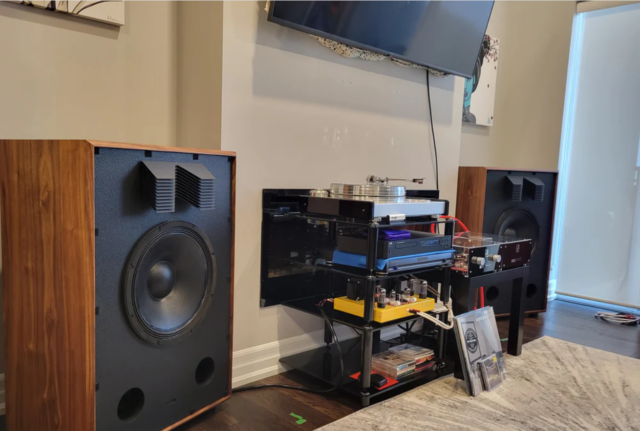 What strikes David right away is that he cannot stop concentrating on the music. Even though the volume is set low, he is just being pulled in and every time he tries to break his concentration, the command to focus on the music just returns. Noam is making coffees (yummy lattes) and is looking over his shoulder from time to time. He is chuckling while just watching all this unfold.
What strikes David right away is that he cannot stop concentrating on the music. Even though the volume is set low, he is just being pulled in and every time he tries to break his concentration, the command to focus on the music just returns. Noam is making coffees (yummy lattes) and is looking over his shoulder from time to time. He is chuckling while just watching all this unfold.
Noam then puts Van Morrison’s ‘Astral Weeks’ on the turntable -an album David must have heard a hundred times before. Like Greil Marcus, David reveres this album as one of the best things to emerge from modern music. Van’s youthful voice just penetrates the room and Richard Davis’s bass lines sing out from the speakers like silk. The track ‘Down on Cypress Avenue’ comes up for play and David gets even quieter. This ‘tour de force’ strikes him in fresh ways – the vocals are superb, the story of young love is haunting. He is devastated.
Noam is also unusually quiet and is just watching David for a reaction. Pretty much ‘speechless’ is the only reaction forthcoming. The Kensingtons have taken our breath away. They just draw you in with their magic and won’t let go.
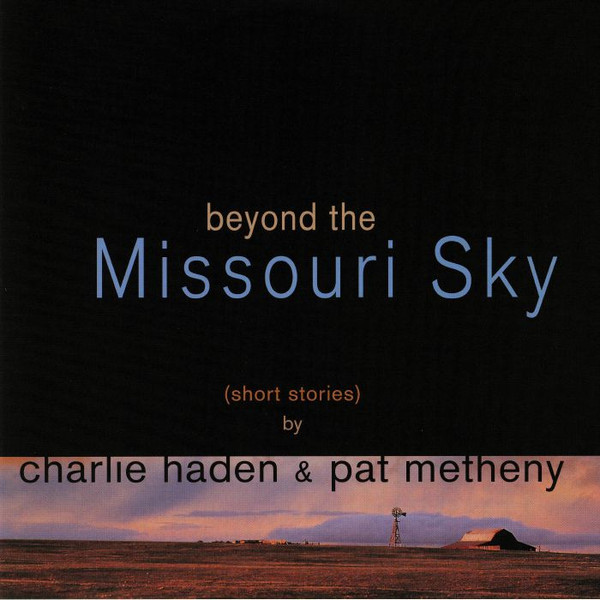 David says to Noam; “Well, that was exceptional, possibly the best I have ever heard”. Noam demurs, but admits that he has been spoiled ever since the ‘Kensies’ arrived. Of course it’s not just the speakers but the entire system we are listening to that includes an Acoustic Solid turntable, a Nagaoka cartridge, a John Curl Parasound phono preamp, a new NAD CD player, an exceptional Triode Lab Conductor pre-amp, and a Finale Sesto Elemento ST 6V6 power amplifier. But the sense that it is primarily the speakers that are responsible for the effects we are hearing is hard to throw off.
David says to Noam; “Well, that was exceptional, possibly the best I have ever heard”. Noam demurs, but admits that he has been spoiled ever since the ‘Kensies’ arrived. Of course it’s not just the speakers but the entire system we are listening to that includes an Acoustic Solid turntable, a Nagaoka cartridge, a John Curl Parasound phono preamp, a new NAD CD player, an exceptional Triode Lab Conductor pre-amp, and a Finale Sesto Elemento ST 6V6 power amplifier. But the sense that it is primarily the speakers that are responsible for the effects we are hearing is hard to throw off.
To my surprise these speakers shatter several myths. The most long standing myth is that all compression horns either honk or quack. I cannot detect so much as a smidgeon of honk from the tweeter. A second myth is that all large woofers are inherently lazy and mushy sounding. The big Faital Pro woofers in the Kensingtons are lightning fast and articulate. The Kensingtons are a dual front-ported enclosure but there is no bass hangover or chuffing detectable.
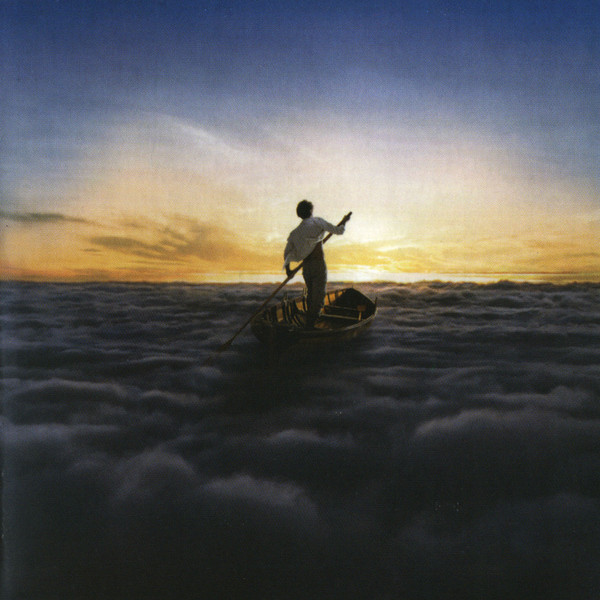
But the real surprise is how ‘effortless’ they are. The music just seems to float out of the enclosures with no sense of being forced. Even on the most congested passages there is no sense of shouting. And despite the huge enclosures they image like champions. Without doubt they are exceptional at low volume levels, the best I have ever heard.
We spend the next hour or so working through several albums and CDs by artists as diverse as Mae Moore and Lester Quitzau, Shirley Horn, and Pink Floyd, and the ‘Kensies’ handle all of it with ease. Not a lot of conversation ensues but we agree that the Kensingtons are the real deal. I leave with dreams of winning the lottery and having a pair in my listening room.
The Second Listening Session
David arives at Noam’s place and notes that the Metheny/Haden CD (noted above) is once again quietly playing at very low volume levels on the Kensingtons. The last cut ‘Spiritual’, is in play and the mournful effect of the track is haunting. Right away David is being pulled in to these speakers and we decide to replay the entire CD while drinking coffee, eating cookies and engaging in light and sparse conversation.
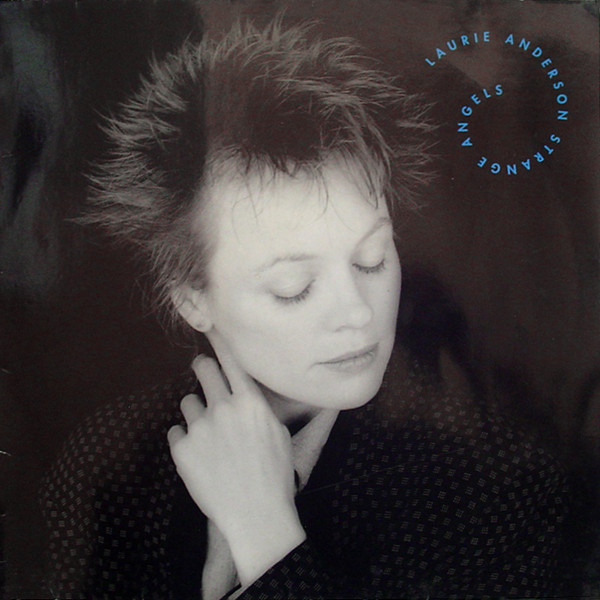 Then we move on as David has brought some CDs and so we start to work though the stack. First up is Laurie Anderson’s ‘Strange Angels’, highlighting the last track ‘Hiawatha’, a real performance art piece. The purity of Anderson’s voice is striking as is the studio production of the track. Once again the effortless presentation of the Kensingtons dominates David’s thoughts.
Then we move on as David has brought some CDs and so we start to work though the stack. First up is Laurie Anderson’s ‘Strange Angels’, highlighting the last track ‘Hiawatha’, a real performance art piece. The purity of Anderson’s voice is striking as is the studio production of the track. Once again the effortless presentation of the Kensingtons dominates David’s thoughts.
“I think it’s the mid-woofer size”, says David. “The total surface area of that driver must be about four times the area of an eight inch driver. Even on parts of that track that can sound congested there is excellent articulation”, David remarks. Noam agrees and adds that it appears that it (the woofer) can deliver more sound with less compression. The illusion continues that the notes just seem to float out unforced from the Kensingtons.
We switch gears and put on some light pop/jazz female vocals, notably Katie Melua and then Rose Cousins. Cousins’ voice in particular is compelling and the production values of this CD (‘Natural Conclusion’) are as good as it gets. Neither Noam nor David talk very much. There just doesn’t seem to be a lot to say.
As the last notes of the track ‘Freedom’ fade away David asks; “Is this the best system you’ve ever had?”
Noam replies; “Funny, but the word going over in my mind is luxurious. And I’ve never aimed to have ‘luxurious’ systems. Having a store now, I don’t think of the gear as mine. But yes, at least in terms of the speakers and the preamp, the turntable and in some ways the phono stage, these are pretty much the best I’ve had.”
Finally we turn to an old favourite, ‘Raising Sand’ by Robert Plant and Alison Krauss. Like putting on a well-worn shoe, this CD has seen lots of play and can reliably be used to anticipate a speaker’s range and ability. The track ‘Polly Come Home’, a song penned by Gene Clark, opens quietly and then offers a huge kettle drum roll that admirably shakes the soul. Noam notes the extensive use of reverb in the track which the Kensingtons ably highlight. David notes to himself that with each speaker he has heard this track on, each sets the pace of the music, which is languid and ominous, at a slightly different point. David comes to the conclusion that the pace set by the Kensingtons is likely spot on with the studio recording.
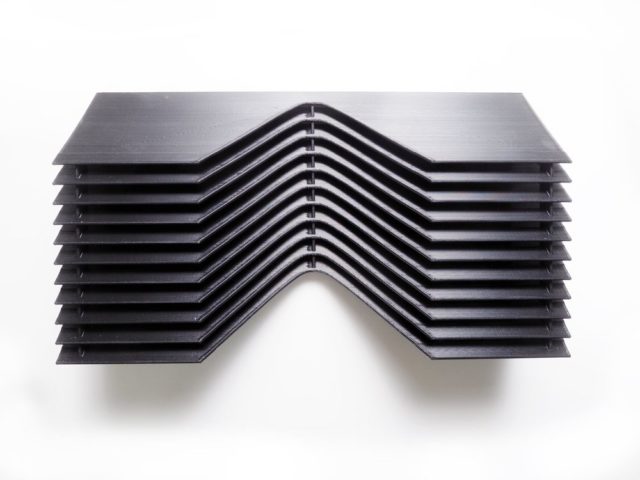
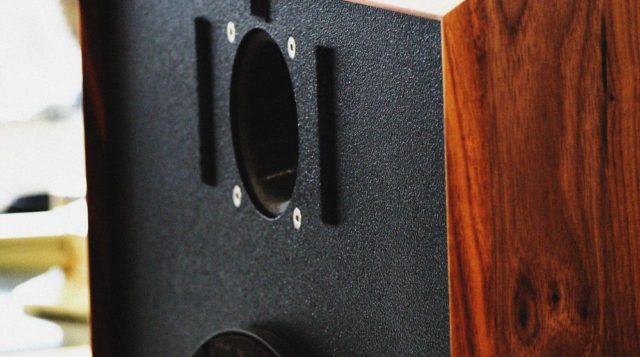
To round out this listening session we listen to Plant and Krauss do their version of ‘Please Read the Letter’, a Page-Plant staple. Plant’s voice is right in the room and the solo Krauss plays on violin weeps as appropriate. The end of this song can always get shouty as there is a lot of compression and congestion that can build up in the woofer and tweeter as the rock intensity at the end of the track rises.
Noam notes: ‘That was a bit of a torture test – a budget digital front end, a busy rock track, and we’re only sitting back about eight feet from the horn tweeters. The final chorus (where they sing in unison) was bordering on edgy for me. But that could just be the recording.” David finds the end of the track only a little bit edgy as compared to other speakers he has auditioned. Indeed it was a torture test. (Later Noam realizes that his wall hanging that usually covers the TV wasn’t in use for this session…)
David departs for home with the performance of the Kensingtons filling his mind with possibilities. Upon arriving home he immediately begins penning the outline for this review.
The Third Listening Session
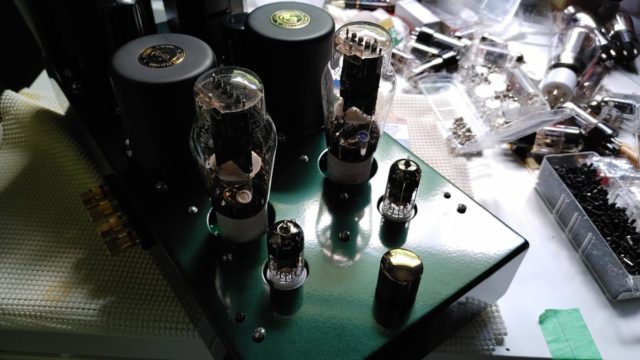
Almost a month passes between the second and third listening sessions, as summer plans (and plan B’s) unfold. In this interval a few changes occur in the accompanying equipment. For this final session the Triode Lab/Finale separates have been replaced by a Triode Lab 45 Mini amplifier, with all of its two watts of triode output per channel. In addition, Noam had swapped out the Parasound phono preamp for a Gold Note PH10, a well regarded alternative. Finally the workhorse Nagaoka MP-200 cartridge has been retired and replaced by a Gold Note Donatello Gold MC cartridge.
We started the session with vinyl, in this case Kenny Burrell and Side 1 of Music Matters reissue of the Blue Note classic ‘Midnight Blue’. David comments; “It all just seems so impossibly smooth’, and Noam remarks; “I was thinking exactly the same thing.” We agree that this smooth character probably owes partly to the Gold Note phono stage and the Gold Note cartridge with the effects of the 45 Mini also in the mix.
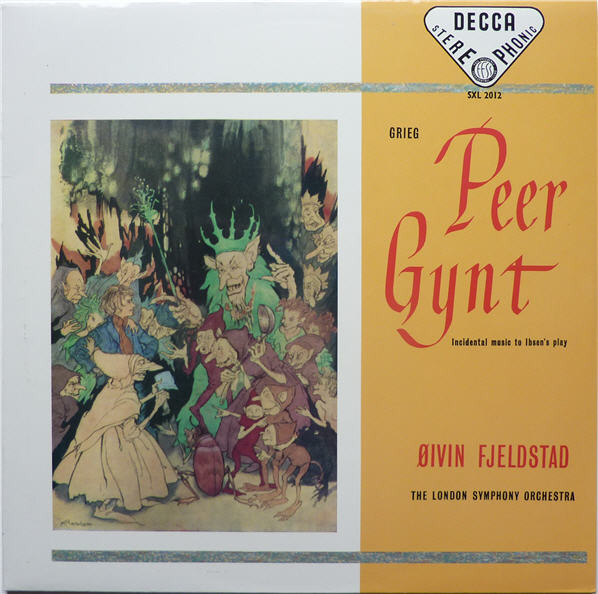 We then turn to ‘Peer Gynt’ by Grieg, Side 1, in this case a reissue of Decca SXL2012, a famous early stereo 1958 recording made during the “Decca tree” mic heyday, engineered by Cyril Windebank. This is music we’ve all heard in films. We were trying to get a sense of how the Kensingtons handle varied orchestral material, particularly from a recording made prior to the digital era. David observes; “They are certainly capable of convincing orchestral effects. They image beautifully at about row M in the concert hall, smack in the middle.” Noam, sitting off to the side, misses the soundstage but hears a great sense of scale and weight, as well as dynamics. And superb tone.
We then turn to ‘Peer Gynt’ by Grieg, Side 1, in this case a reissue of Decca SXL2012, a famous early stereo 1958 recording made during the “Decca tree” mic heyday, engineered by Cyril Windebank. This is music we’ve all heard in films. We were trying to get a sense of how the Kensingtons handle varied orchestral material, particularly from a recording made prior to the digital era. David observes; “They are certainly capable of convincing orchestral effects. They image beautifully at about row M in the concert hall, smack in the middle.” Noam, sitting off to the side, misses the soundstage but hears a great sense of scale and weight, as well as dynamics. And superb tone.
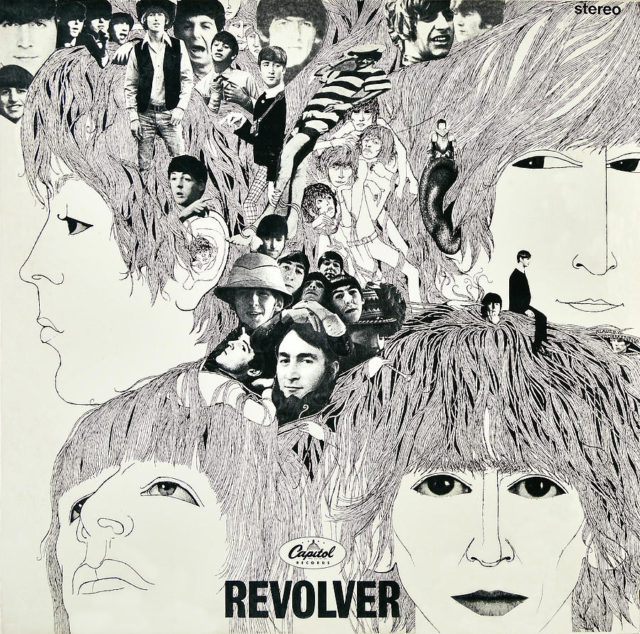 Next up, some light rock via the Grateful Dead’s ‘American Beauty’ followed by a Mono pressing of the Beatles ‘Revolver’. The ‘Revolver’ selections are a revelation. The two big Kensington boxes look and act like the giant mono speakers that were preferred by audiophiles before the advent of stereo. Surprisingly, even in mono, the Kensingtons can resolve all the fine details that the Beatles built into their records. I chalk this up to the 15 inch mid-woofer which has enough surface area to clearly differentiate the inner details.
Next up, some light rock via the Grateful Dead’s ‘American Beauty’ followed by a Mono pressing of the Beatles ‘Revolver’. The ‘Revolver’ selections are a revelation. The two big Kensington boxes look and act like the giant mono speakers that were preferred by audiophiles before the advent of stereo. Surprisingly, even in mono, the Kensingtons can resolve all the fine details that the Beatles built into their records. I chalk this up to the 15 inch mid-woofer which has enough surface area to clearly differentiate the inner details.
Then we turn to CD replay and begin with ‘The Best of John Coltrane’ and the selections ‘Equinox’ and ‘My Favourite Things’.
David is immediately immersed in ‘Equinox’. He remarks: “The upper registers of Coltrane’s tenor sax are so clear and bright that you can almost be fooled into thinking he is using a soprano sax for those sections”. Noam remarks; “With Coltrane there’s nobody else who sounds like him and the improvisations just flow out of him effortlessly”.
We move on to Van Morrison’s ‘Healing Game’ and sample a few tracks. In ‘Piper At The Gates Of Dawn’ the closing passages feature the use of the Irish bagpipes as played by Paddy Maloney. The Kensingtons do a fine job of reproducing those haunting and mournful sounds. The title track mesmerises us as Van does his extended ‘one more time!’ style closeout refrain.
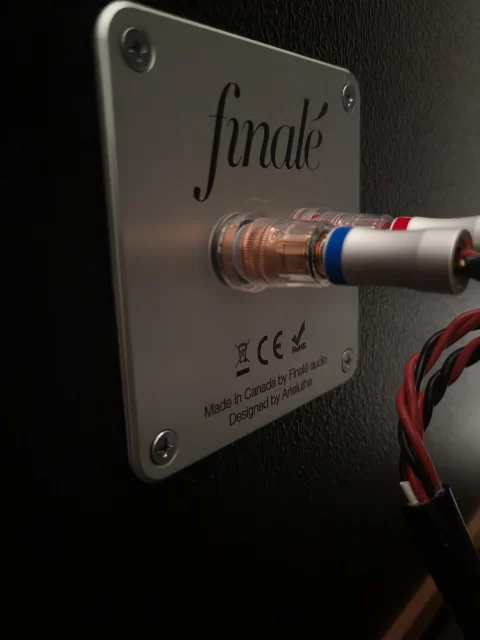 Next we play Allison Brown’s CD ‘Stolen Moments’. Brown is a virtuoso banjo player who attracts excellent side musicians. We listen to several tracks and David comments on how “the speed and resolution of the Kensingtons is really exemplary”. Brown plays at blinding speed, as do the other musicians on her tracks – yet each note is clear and distinct with lots of separation.
Next we play Allison Brown’s CD ‘Stolen Moments’. Brown is a virtuoso banjo player who attracts excellent side musicians. We listen to several tracks and David comments on how “the speed and resolution of the Kensingtons is really exemplary”. Brown plays at blinding speed, as do the other musicians on her tracks – yet each note is clear and distinct with lots of separation.
We then run through a few selections by Cassandra Wilson and Buddy Guy, and then I ask Noam to specifically replay one more time the Pat Metheny and Charlie Haden track ‘Spiritual’ from the CD noted in session one and two above.
“Right there, this is the music these speakers were designed to reproduce”, says David. “You cannot get away from them – they just draw you in with their powers and all conversation ceases”. It is a remarkable piece of music and Noam concurs as it fades off, casting a sunset glow on our final moments of ‘evaluation’. This was about as relaxed and as far from ‘work’ as a review can be…and the camaraderie shared made it a special experience.
David’s Post-Session Observations
What happens when you return to a more modest set of speakers after listening to the Kensingtons? I tried that experiment by listening to several of the same CDs we auditioned with the Kensingtons, on my DALI Oberon 5s.
Now before we slag the Oberon 5s it is important to appreciate that they are considered some pretty fine speakers with lots of five star awards, even one by yours truly. Normally they are highly satisfactory, but at around a MSRP of $2000 a pair (currently) they are leagues below the Kensingtons in what they aim to deliver.
The most notable characteristic of the Oberon 5s, after hearing the Kensingtons sing, is that they are impossibly coloured by a host of box colourations that dampen the purity of the voices and instruments. Even at very low volume levels there is a see through (or hear through) kind of electrostatic quality to the Kensingtons which is highly addictive and once you have adjusted, it becomes very hard to readapt. The purity of the midrange is a revelation and the sweet treble is highly coherent and seems just right. One has the impression that you are hearing the music as live music, through an open window; unforced and free of so many colourations.
Yet the Kensington is still a box speaker, so that aspect is all the more impressive given their performance. Somehow that big 15-inch woofer manages to convey the most delicate aspects of the music, and it can keep all those tiny cues of the tonal colour of instruments and voices intact. In retrospect I keep thinking about the Kensingtons by mentally using the phrase – ‘Oh – but the delicacy’.
Overall, listening to my DALI Oberon 5s was a bit of a let-down after auditioning the Kensingtons and I am not sure what I will do next on the speaker front.
Conclusion
This is my first encounter with big horns outside of hearing many pairs at audio shows and leaving unsatisfied. It was a pleasure to audition them and we wish their future owners well as they will have purchased something very special.
Finally, Wall Of Sound awards the Finale Kensingtons a Gold Star for exemplary sound and long term value. The price will be an obstacle for some, but essentially these are custom built speakers from a designer with a specific vision and proven capability – Robert has several established brands, e.g. Gemme, Arteluthe and Heretic. There are similarly priced speakers that are now middle of the range for companies like Spendor, JMR, Harbeth and ATC. Value is surely a relative concept, but on sound quality alone the Finale Kensingtons deserve a Gold Star.
Really, you may have to go out of your way to hear them but we cannot imagine you will be disappointed. Bravo!
SPECS:
-
System: Front Firing (Dual Port) Bass Reflex Acoustic Design
-
Horn type : Exponential horn supplemented acoustic lens louver-type
-
System: 2 way
-
Frequency Response: 35-20000 Hz
-
Cross-over: Linkwitz-Riley, 12 dB / octave (second order), serial type, crossover frequency 1200Hz
-
Power handling: 400 watt RMS
-
Recommended power: from 10 to 200 Watt RMS or more – without clipping
-
Sensitivity: 100 dB @2.83Vrms/1 meter
-
Nominal impedance: 8 ohm
-
Size: 24-1/8″ W x 15-1/2″ D x 35-5/8″ H (for full depth add 1″ for terminals & 2″ for grille/lens)
-
Weight: 75 lbs
-
Shipping : 2 Wood Crates 46”X32”x30”
-
Designed and manufactured in CANADA
Finish : Natural North American Walnut Veneer (With fabric protective grills)
MSRP $12,999
Disclosure: Noam Bronstein (Editor of Wall Of Sound) is also a dealer for Finale Audio, Triode Lab, and other brands mentioned in this review.

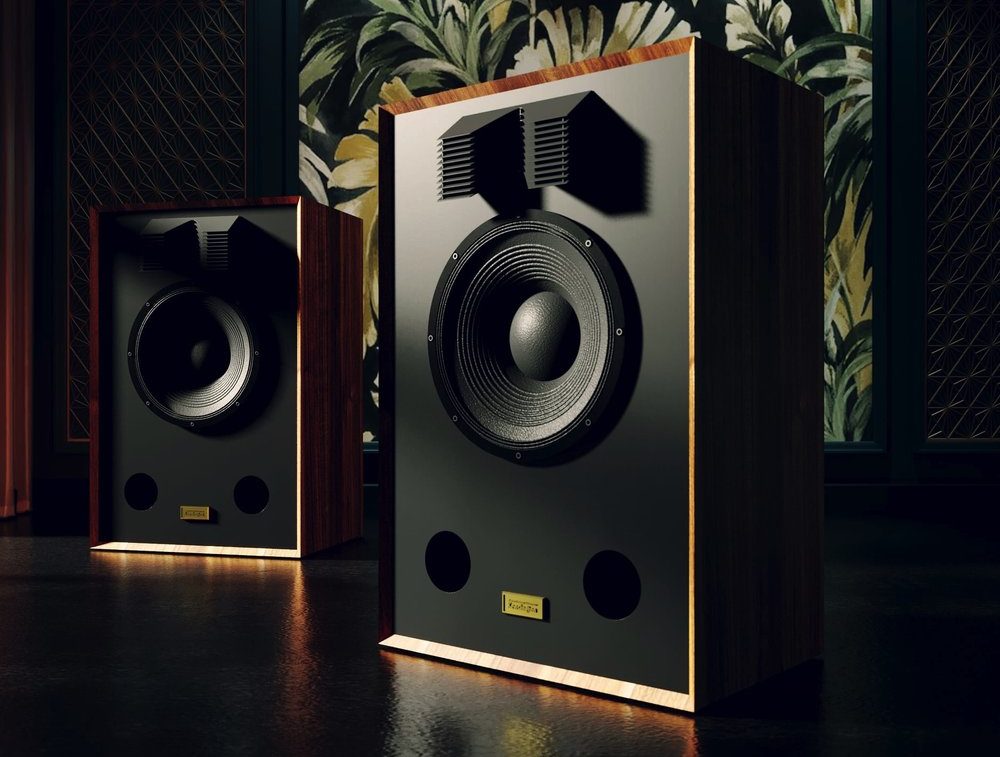
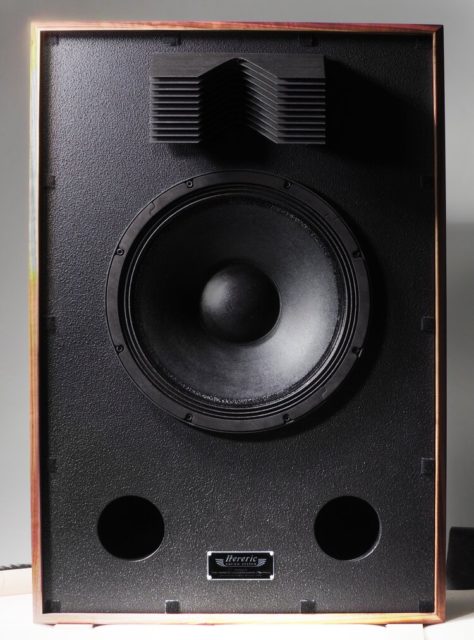
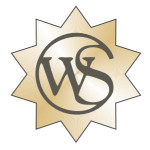
This looks very much like an update of the JBL L200 from the late 1960s or early 1970s. And that basic design—15″ LF unit + compression driver on horn lens—goes back to the 1920s!
With carefully matched components and an appropriately designed crossover, I’m not surprised it’s a very satisfying music reproducer.
It’s the same basic design I’ve been enjoying for decades in various iterations—though I tend to favor active crossovers. But, especially given the price, I suspect you are praising he product rather more than it merits.
Thanks for your comment, Joel. Pricing on the Finalé Kensingtons reflects the cost of building and transporting them. It’s competitive with the Cornwall IV, Tannoy Arden, Coherent, DeVore, etc. This past weekend I had a visitor who’s owned the Cornwall III and IV, and said there was no contest. The Kensies are built better and sound better.
Noam
Measurements would show how compromised on-axis response, directivity and low frequency response are in order to achieve the claimed sensitivity, which most likelyis closer to 96dB with low end roll-off at 50Hz (-6dB). It’s very light for th size so little bracing and resonant cabinet most likely.
The cabinet doesn’t resonate, claimed sensitivity seems about right, and there is good response at 40Hz. The speaker sounds excellent across a wide range of music. We aren’t measurement guys here.
Best regards,
Noam
Thank you, sunds about right, excuse the pun. Seems clear you have never built, let alone measured a speaker, so referring you to the relation between volume displacement and low frequency response would be a fallacy. Funny how engineering principles apply to every aspect of engineering, apart from loudspeakers governed by magic and evaluated by golden ears. Test or taste the holy water, that seems to be the question.
Different strokes for different folks. I like to listen to speakers as distinct from parsing frequency response curves. But to each their own I say.
I don’t read much hifi stuff in the summer months so just got round to reading this now. Much appreciated David and Noam for taking us on your listening adventure. Read it last night and found myself pulling up Missouri Sky to listen along – would love to have been with you in Noam’s listening room but this is next best thing. Will watch for these speakers in the future – maybe they will be there next time I make a audio show here on the west coast.
Great to hear from you, David!
Great review, sounds like this could be an end game loudspeaker. I came away with the impression the Kensington could do it all. Every part of the spectrum is important, but the upper midrange & treble seem to be the hardest to reproduce correctly. You have electrostatics, ribbons, dynamic drivers etc., responsible for resolution & transparency, sound stage width & depth, instrument placement. If you don’t get cymbals right forget it. Could you elaborate on this area & maybe compare to others speakers you’ve heard. Thanks, Michael
Hi Michael,
It’s Noam here. I’ve owned Quads, Maggies, hybrids like Soundlab, open baffles, back loaded horns, and plenty of dynamic speakers. What I love about the Kensies is the ease of their presentation. They don’t sound hyped or artificial, just give them a half decent tube amp and a nice acoustic recording, and everything sounds natural and unforced. Creamy smoothness without lacking in detail. They are capable of large dynamics – e.g. the Peer Gynt mentioned in the review. To be really convincing as a rock speaker, they might need more power. We all hear differently and have our own musical priorities..I don’t think any one speaker can cover every single scenario perfectly. These come pretty close though. The “compromise” here being that they’re big.
David may have some other comments to add.
All the best,
Noam
Thank you Noam for your response. I love big speakers and am always checking out reviews of loudspeakers with 12” woofers or better. These would be for my vacation home, just waited for the proper time to invest. At home I took two JBL 12” woofers out of some old 100’s I got cheap & put them into my own cabinets. Then bi-amped them to a pair of Grant Fidelity MBS-1’s monitors for a killer sound, all things being relative. Tubes on top, Bryston 4B on bottom. Thanks again, Michael